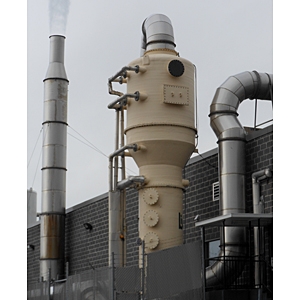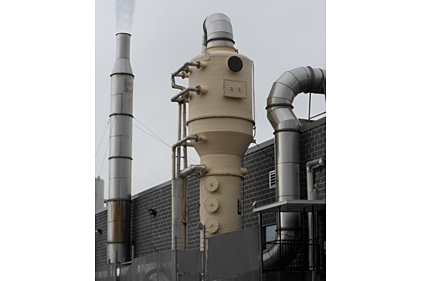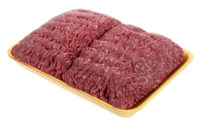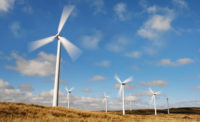Polarized Meat Co., Dunmore, Pa., produces high-quality meat products that are designed to reduce preparation time at restaurants. Certain products are  pre-formed and pre-cooked, often with grill marks to enhance the products’ visual appeal and flavor. Both the incoming meat and the final products are quality controlled throughout the process.
pre-formed and pre-cooked, often with grill marks to enhance the products’ visual appeal and flavor. Both the incoming meat and the final products are quality controlled throughout the process.
Given the temperatures applied, the grilling process releases some aromas and greases. The design of the processing equipment collects these emissions and ventilates them, so that a clean and well-ventilated workplace environment is maintained. However, to be a good neighbor and meet Pennsylvania emissions requirements, Polarized Meat investigated ways to control the emissions exiting the facility.
“The issue we encountered was being situated upstream from a neighborhood occupied by a few people that had an aversion to the occasional aroma of cooked meat,” says Michael Bernstein, executive vice president.
Although the aroma was intermittent (dependent upon the way the wind blew each day), neighbors complained to Pennsylvania’s Department of Environmental Protection (DEP).
“The DEP took a hard line position and forced our hand to find a solution to the problem,” adds Bernstein.
Farnham and Associates, a Clarks Summit, Pa.-based environmental consulting firm, was hired to investigate an effective means of meeting both the company requirements and state regulations. This proved to be a daunting task. The processing of fully cooked meats is quite complex, and can release condensable greases, soluble aromas and less soluble products. Polarized Meat makes various products on multiple processing lines that exhibit different grease and aroma emissions. In addition, the rate of emissions varies since the company shuts down specific lines for cleaning, maintenance or equipment upgrades.
One proven technology for emissions control involved using an incinerator (thermal oxidizer). But, the space and energy requirements for this technology ruled out its use. Space was limited, and the quantity of natural gas required to fuel it to more than 800°F proved far too expensive. In addition, the combustion process can produce both CO2 and small amounts of NOx.
Another known technology investigated was wet scrubbing. This process is conducted at a lower temperature and involves the condensation and absorption of the gases into a water solution. Farnham and Associates contacted Bionomic Industries, a Mahwah, N.J., supplier of air pollution equipment, who had experience in wet scrubbing of fryer and broiler emissions. Bionomic Industries provided a quote on an effective system that could fit into the available space and not require huge quantities of natural gas nor produce unwanted emissions and/or pollutants.
It was determined that though wet scrubbing would work on most of the emission, however additional capture was needed for less soluble but still pungent emissions. Activated carbon has the potential to remove aromas from the gas stream. Therefore, it was clear that a multiple-stage wet system would be needed. Condensation would be needed to control the condensables, wet scrubbing would be required for the water soluble portion and adsorption onto carbon would be required for the lower solubility aromas. Best of all, the proposed system would fit into the available space.
The resulting system incorporated a RotaBed pre-scrubber in fiberglass reinforced plastic construction with stainless-steel grids followed by a special gas absorption and coalescing stage and a droplet control for the wet scrubbing stage. A fan pulls the gases from the wet scrubber and delivers them to the activated carbon stage. The cleaned gases then exit through a stack to atmosphere.
“Although the solution of wet scrubbing followed by activated carbon filters took some tweaking to become operationally sound, we are now operating to the tune of no neighborhood complaints and zero visits from the DEP,” says Bernstein. “The system that we have in place is not only easy to maintain, it is [also] operationally very affordable relative to other technologies we investigated.”



